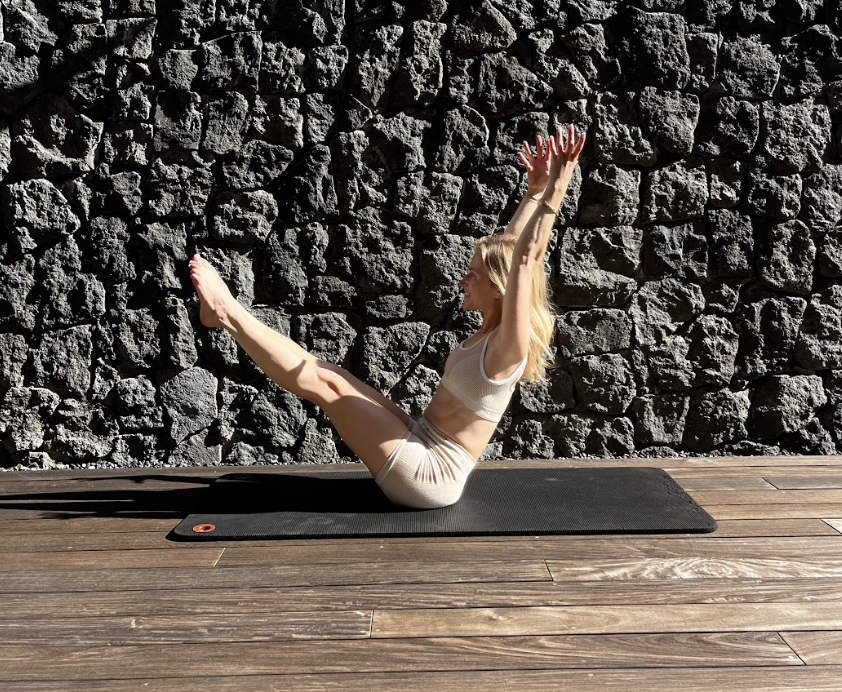I’ve been doing this whole exercise thing long enough to have an idea of when to expect some muscle soreness. I know that no matter how many times I take a [solidcore] class, I’m going to be super sore about 48 hours later. I know that when I do a long run or a hard running workout, my quads will talk to me later that day, and that chest day at Barry’s will always gets me eventually.
But even after all these years, soreness still sometimes surprises me: It might sneak up on me nearly three whole days after a workout, or show up way sooner than expected.
I’m certainly not alone in having delayed onset muscle soreness (known as DOMS, or that soreness that kicks in 24 to 72 hours after a workout) catch me off guard: Exercise physiologist and trainer Tom Holland, MS, CSCS, CISSN, says that clients new to exercise are often amazed that they feel fine one day after their workout, but have a rude awakening on day three.
It’s perfectly normal to experience DOMS after a challenging workout, especially if it’s a type of exercise that’s new to you. But the more immediate feeling of soreness is less straightforward—and could be a sign that something else is afoot. Here’s what the experts say the timing of your muscle soreness can tell you about your workout.
When you can expect DOMS, and what it means
If you’ve ever experienced tender, stiff, tired muscles a few days after a workout, you know DOMS, which is caused by your body trying to repair the microscopic tears in your muscle fibers that occur during intense exercise. (No, it’s not caused by lactic acid buildup, a common misconception.) DOMS can range from slight stiffness to debilitating, can’t-get-out-of-bed pain, says Timothy Coyle, MS, an exercise physiologist at the Hospital for Special Surgery in New York City.
You’ll probably experience some DOMS anytime you try a workout that’s new to you, or that you haven’t done in a while, says Holland, even if you’re an experienced exerciser. Those with more fitness experience may even get more sore in some cases, says Holland, since they likely have a stronger connection to their body and might be engaging more and deeper muscles.
“It’s all about muscle activation patterns,” Holland says. For instance, sometimes he has clients do a go-to workout backwards (starting with the exercise they usually do last), and they’re shocked to find that they get sore. “They’re pre-fatiguing in different ways, so the muscle activation patterns change a little bit,” he says.
You’re most likely to feel some DOMS if you do anything that involves lots of eccentric muscle contractions (when the muscle is lengthening), like the lowering part of a bicep curl, or the way your quads catch you as you run downhill. But rest assured: “For the most part, you’re never going to feel quite as sore as you do that first time,” says Holland, “because your body gets stronger.”
When the soreness sets in sooner
Sometimes, it doesn’t take so long to feel the sensation of soreness: During challenging workouts, you may experience what’s called acute muscle soreness, which is caused by the buildup of metabolites (like that oft-misunderstood lactic acid).
But, says Holland, those metabolites will be out of your system not long after you finish working out. So what’s to blame for that feeling of soreness that might set in a few hours later—too late for acute muscle soreness and too early for DOMS? Usually, says Holland, the culprit is actually just muscle tightness, which could be caused by anything from not warming up to poor form to muscular imbalances or weaknesses to simply overdoing it.
“If we really listen to our body and where that ‘soreness’ is, it may be telling us, this is something you need to strengthen, or work on,” he says.
Building a healthy relationship to soreness
To avoid feeling sore so often, be sure to always properly warm up and cool down, and try to increase the intensity of your workouts gradually over time. But having DOMS every once in a while isn’t a bad thing—it means you’re challenging yourself and hopefully getting stronger.
When you do have DOMS, Holland suggests avoiding trendy tips and treatments that claim to get it over with faster, like cryotherapy (unless you’re an athlete who needs to perform the next day!). You need to go through DOMS for your muscles to repair themselves, so let your body take the time it needs to do this.
Try to resist the temptation to park on the couch, though. Keep moving with an active recovery session like yoga or light cardio, while avoiding doing another round of intense exercise for a few days. “Every hard session should be followed by at least one, if not two, recovery sessions,” says Holland. “Eighty percent of the time we want to go easy. Twenty percent of the time you want to go hard.”
And yes, your workout is still worthwhile if it doesn’t make you sore. “A little bit of soreness is good, but what’s really more important is your frequency, and your safety,” says Coyle. Holland agrees: “Soreness is not an indication of whether or not your workout was meaningful.”
Flash News
Empowering you to live a fit and healthy life





